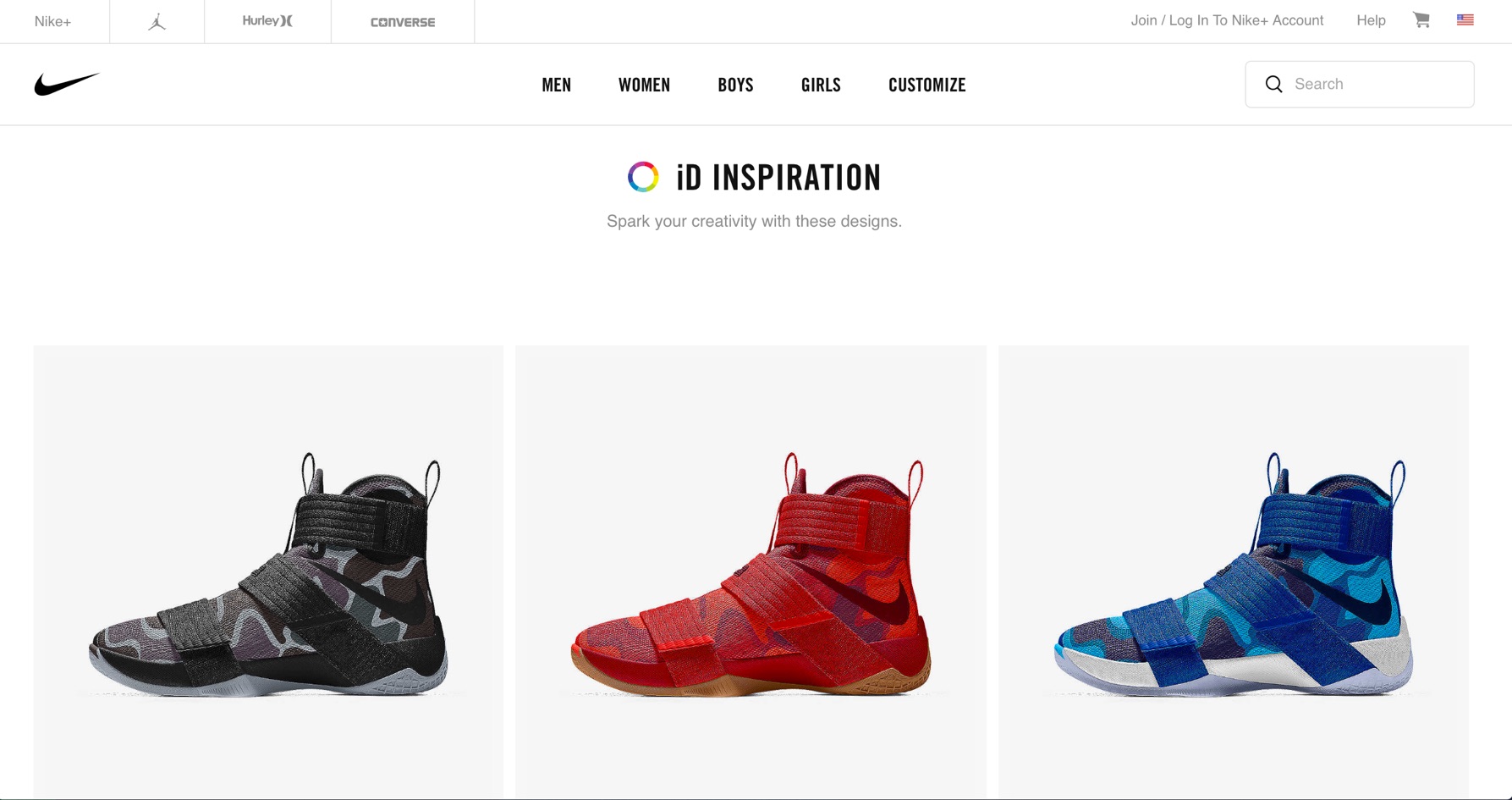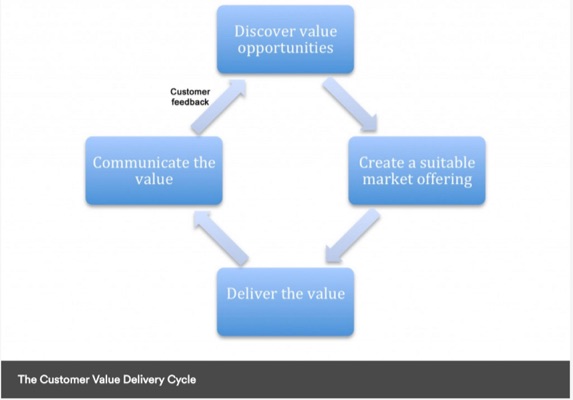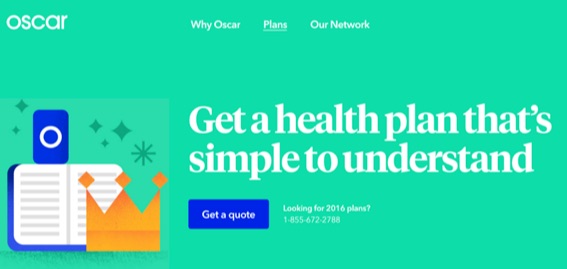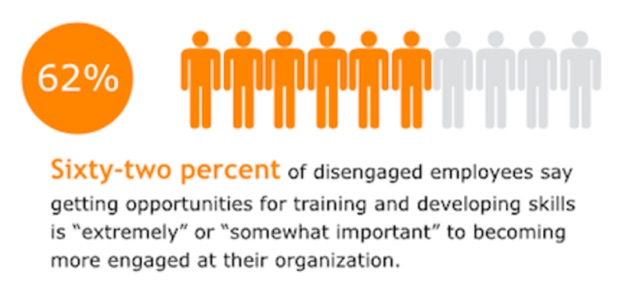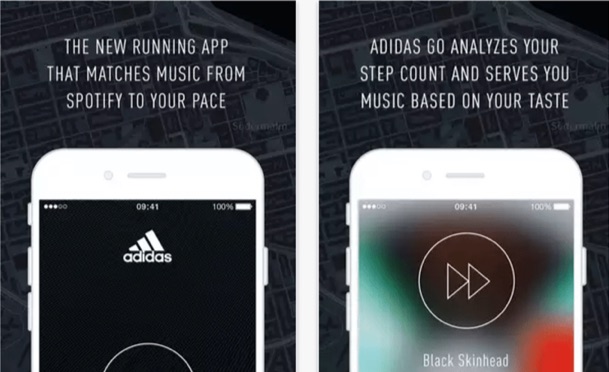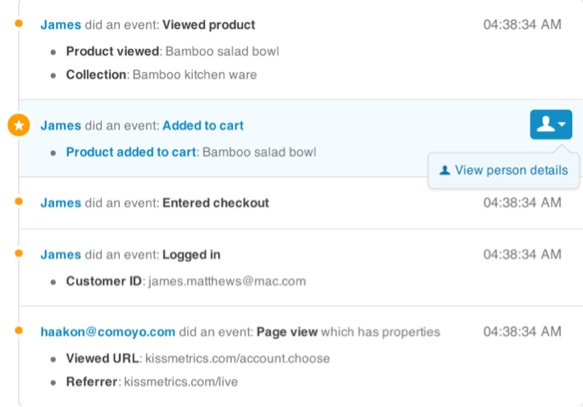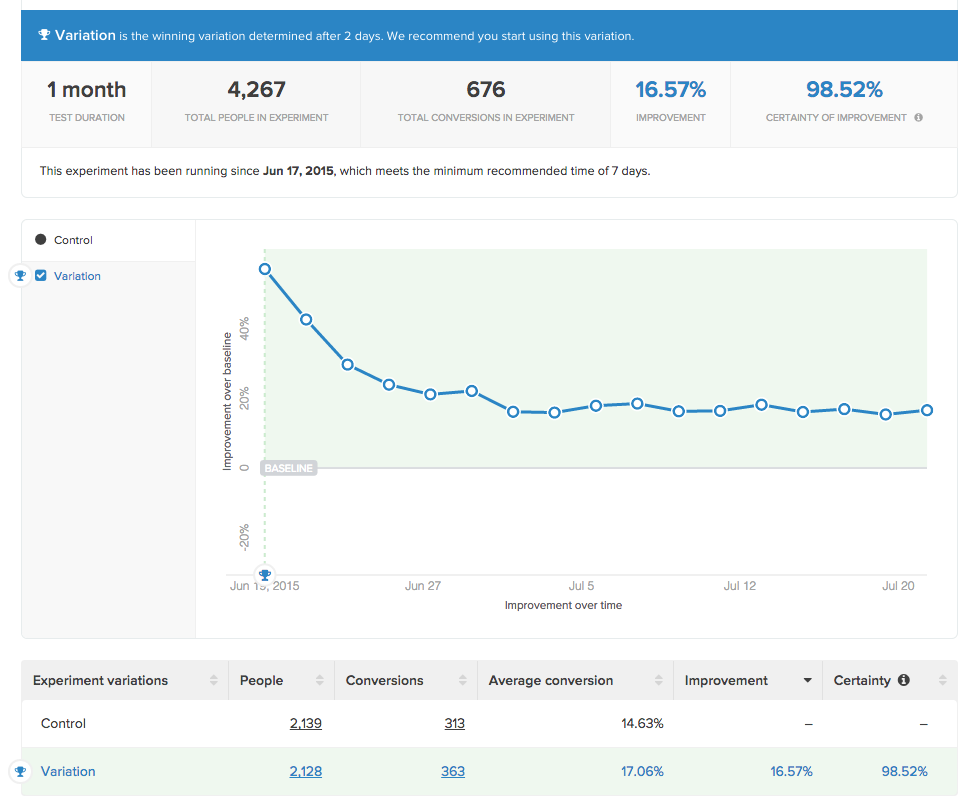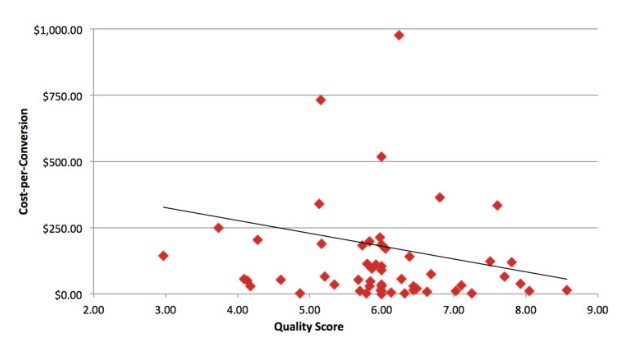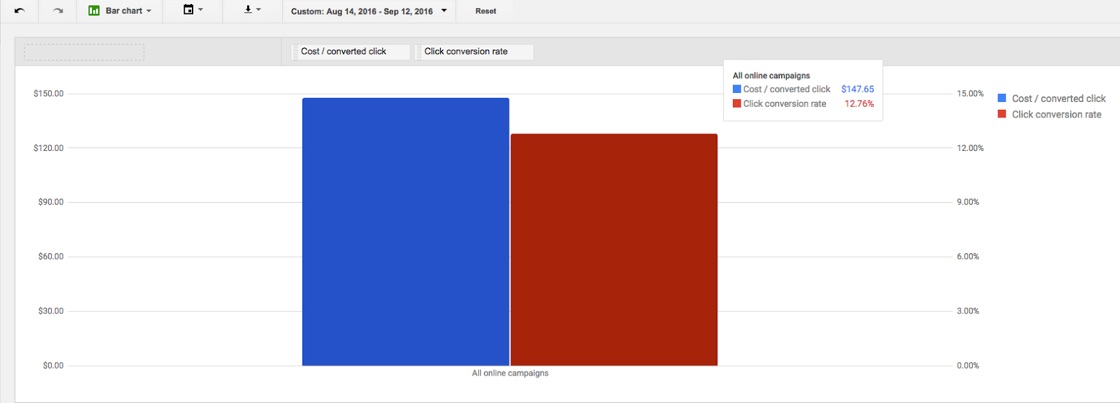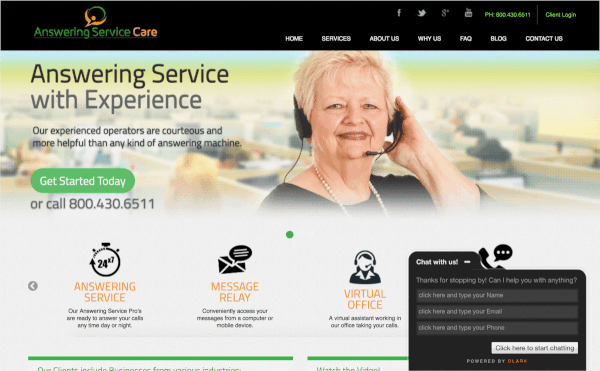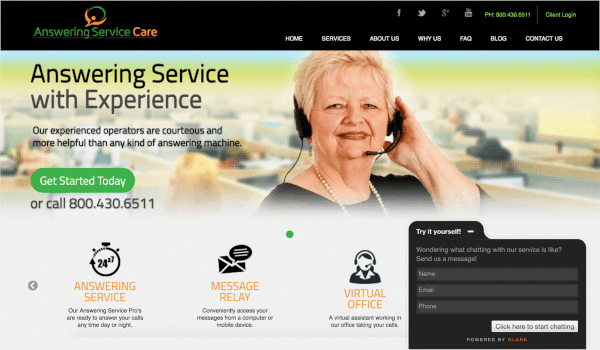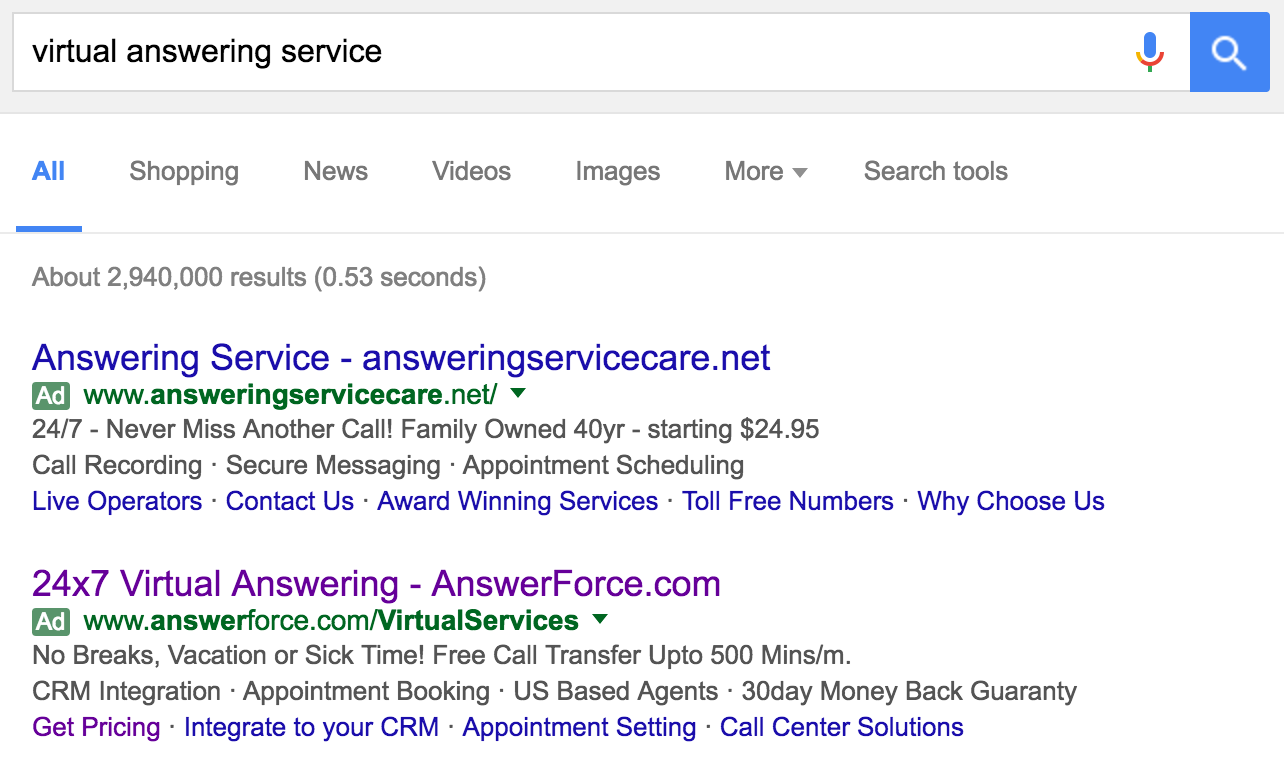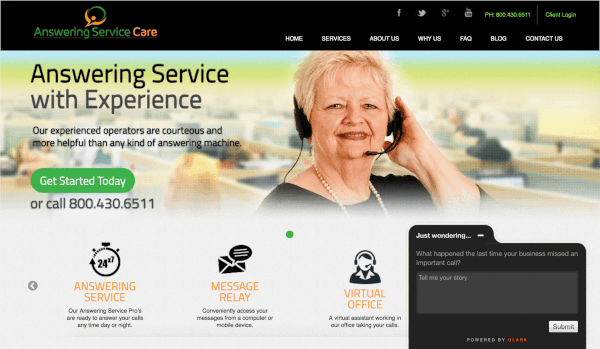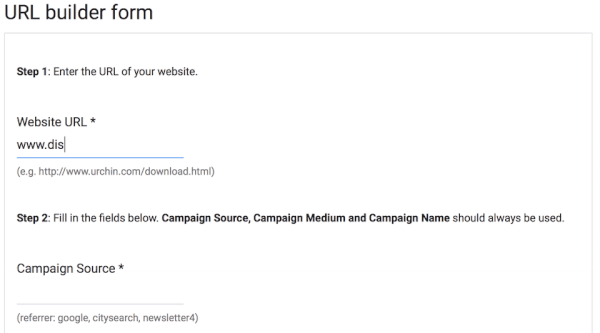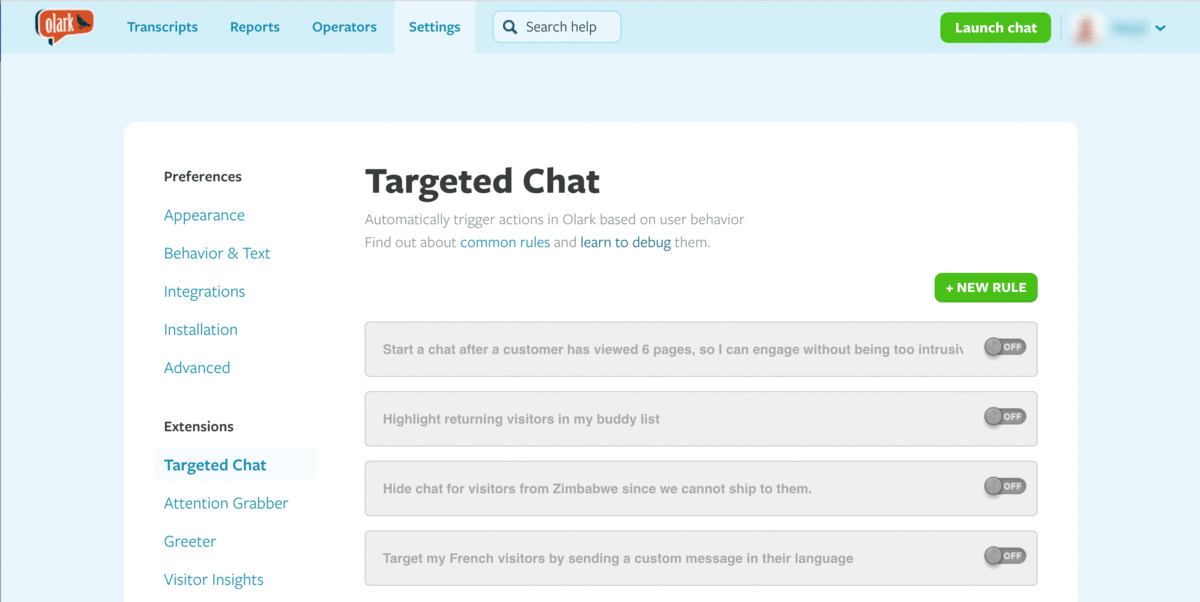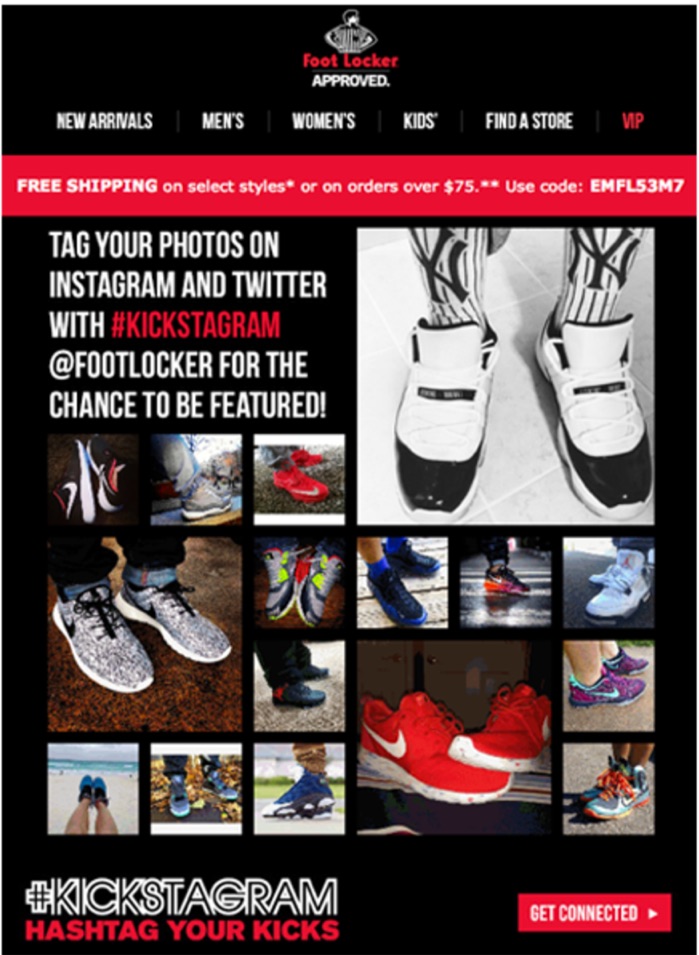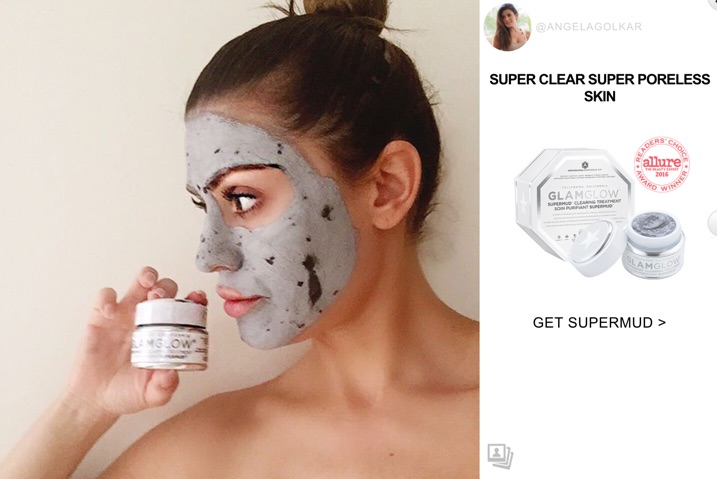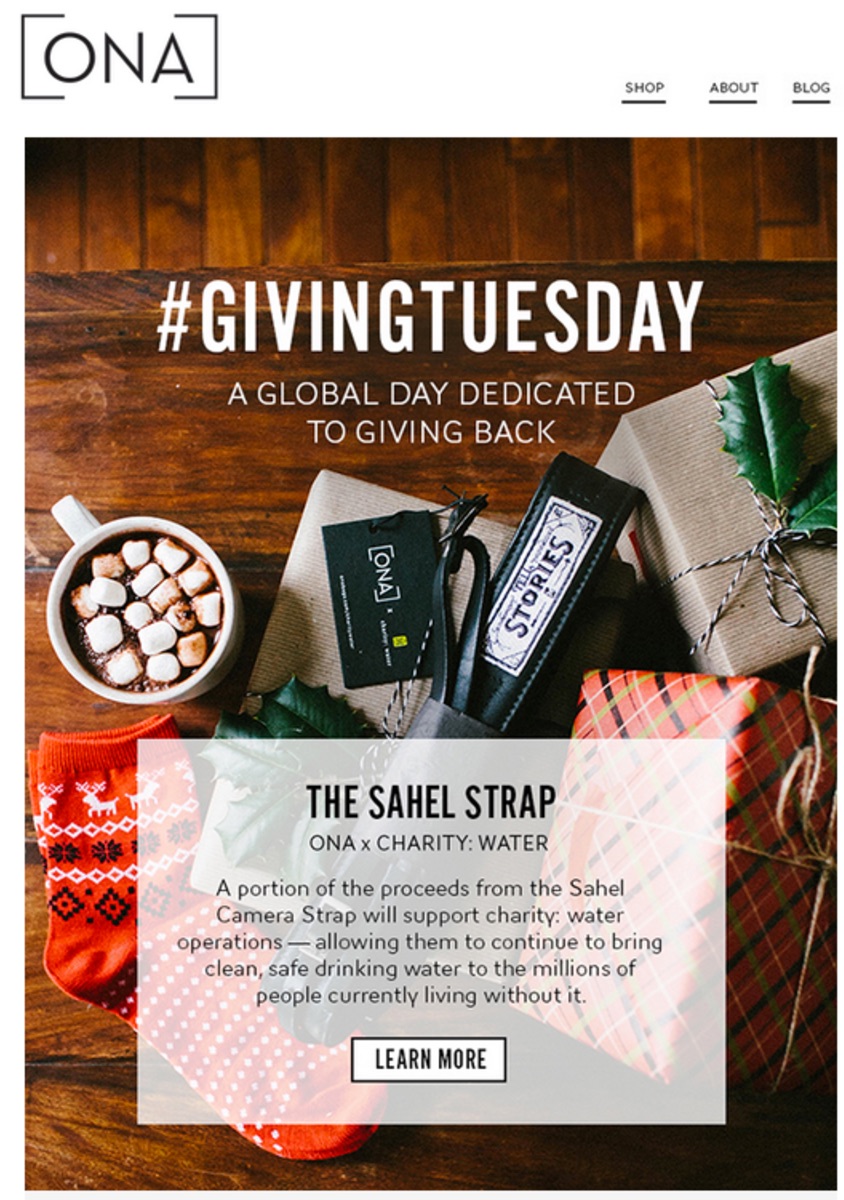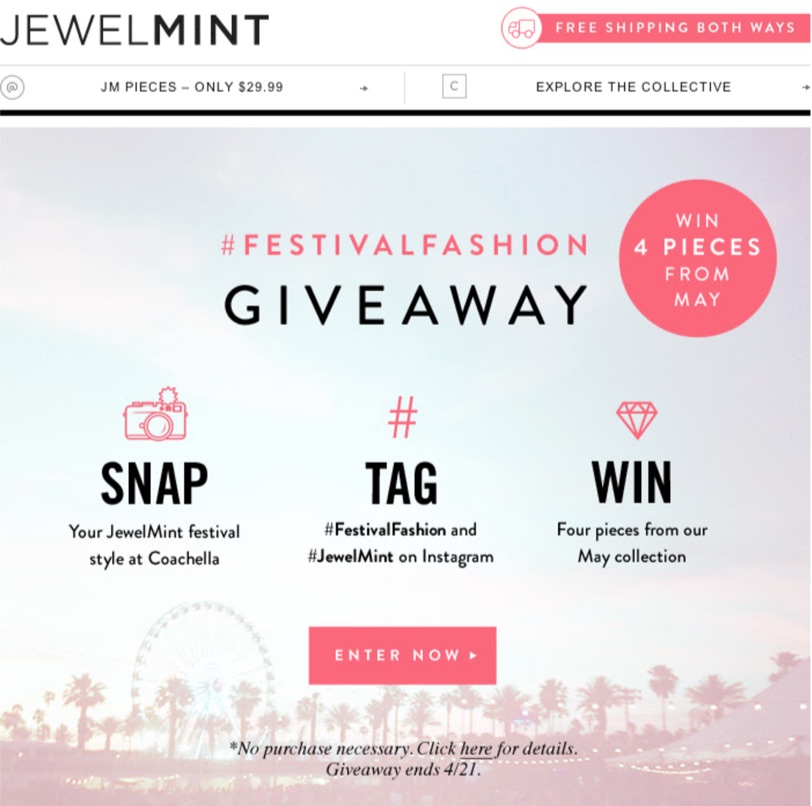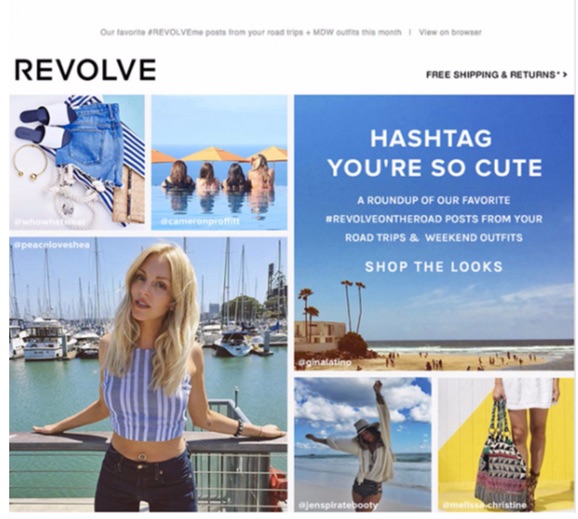Back in college, I visited to this run-down pizzeria shop called Sammi's.
Their logo had a picture of a pyramid on it. No one understood what that had to do with pizza.
I pitched Sammi repeatedly on my startup's text message coupon product at the time. He never bought.
But I'll never forget the time I saw him hand a $200 check to some kid selling an ad from a local magazine like it was nothing.
Two-hundred bucks looks like a lot of money when you're a nineteen-year-old college kid. And especially when all your customers are on free-trial.
What caused Sammi to buy a print ad but not what I was offering?
The education you need to become an effective marketer is just a lot of little experiences like that.
Those experiences are like “flicks” to your forehead.
They are the market saying “Pay attention!” as it tries to teach you something.
In the years since that time at Sammi's, I've started and launched a SaaS business. Today I run a growing subscription-based service business. So far, my team and I have created hundreds of sales funnels for startups and small businesses. I also had the opportunity to lead a Mastermind group for entrepreneurs starting SaaS companies.
From this wide mix of experiences, I've been able to observe several success patterns. These success patterns are relevant to every business marketing itself online-but especially SaaS companies.
I'm telling you this, because what I'm about to share with you is not just theory.
This is about people. It's about the people who are stuck in your sales funnel. It's about the people who haven't heard about your product yet. And it's about the people who are your competitors.
While people may not always behave in a predictable manner, they are influenced by the Laws of Sales Funnel Physics.
Let's jump in.
Note: At 6,300 words, I don't expect you will read this all in one sitting. So I created a free PDF of this resource that you can refer to again and again when it's time to redesign your site.
- Law of Visibility
- Law of Big Changes
- Law of Repetition
- Law of Clarity
- Law of Proof
- Law of Friction
- Law of Alignment
First Law of Sales Funnel Physics: Law of Visibility
What is it?
Imagine two different scenarios.
Scenario A-Relaxing on the beach on a hot summer day with no sunscreen.
Scenario B-Relaxing on the beach on a hot summer day when your doctor shows up to tell you you're at risk of getting skin cancer.
In scenario B, you're going to react right away. You're on the beach without sunscreen, and the doctor has given you urgent information on why you should wear sunblock.
If putting on sunscreen became your “conversion goal” after the need was recognized, B outperforms A, because the offer is right in your face.
That's why the first law of Funnel Physics is the Law of Visibility. In other words, people will convert on offers that are highly visible and noticeable to them.
If they don't see it, they won't convert.
So it all comes down to something being seen.
Now, how can we apply this to your marketing funnel?
Example:
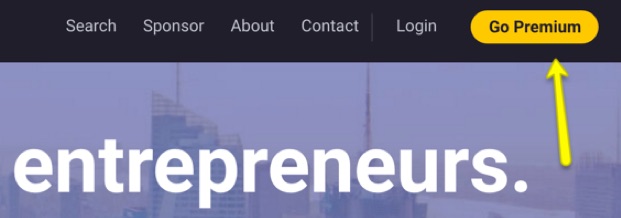
Andrew Warner and his team at Mixergy rolled out a new site design a little while ago.
One thing that stood out to me was the prominent call-to-action button in the top right corner.
It's visible on every page of the website.
This is an excellent example of the Law of Visibility in action. By featuring a highly visible call to action (CTA) for your core offer across your website, conversions are almost guaranteed to increase.
In fact, we did the same thing on our website:
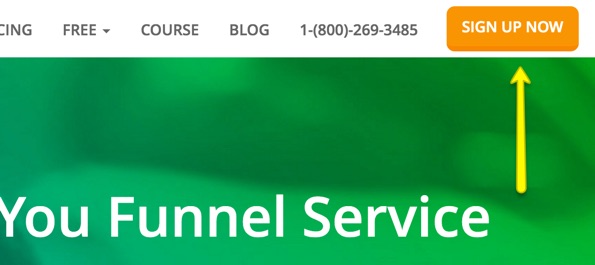
We wanted more people across our website to see and learn about our productized service. You can see below how this change had a sustained impact on how many people viewed our homepage.
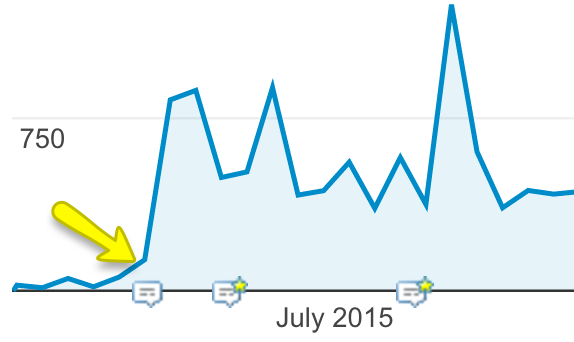
But this is just one example.
How to Apply it to Your Marketing Funnel
Let's brainstorm for a second.
Where can you put in place a simple change like this on your website to cause more traffic to flow deeper into your funnel?
Think in terms of “global” or structural changes that will be seen across many pages on your website.
Here a few ideas off-hand:
- Navigational changes like the example above
- Redesign or add a CTA to your footer
- Install an exit pop-up
- Promote a lead magnet in the sidebar of your blog, as well as at the end of every blog post
- Run a new campaign using Kissmetrics Engage that targets only visitors with a specific offer
Those would be the top ones to implement, especially if your SaaS business is trying to grow via content marketing.
The Bottom Line
Offers-free or paid-that aren't seen, don't convert. So shine some light on them!
Second Law of Sales Funnel Physics: Law of Big Changes
What is it?
Imagine you're an engineer building a cross-country railroad.
But there's a problem: a stretch of mountains lies in-between the train's start and end points.
You have two options: you can lay the track so it snakes around the mountainside, or you can use explosives and heavy drills to create a tunnel that goes straight through.
Which do you choose?
Consider that the universe is (mostly) rational. By this, I mean there is cause and effect.
Nothing happens unless something causes it.
If you want to cause growth in how your sales funnel converts, you have to make a significant change to your sales funnel-the copy, the structure, the design.
Whatever big result you are looking to produce, be prepared for the change to be significant from the customer's standpoint.
That last part is important, because you are trying to influence your target customer, and changes that seem significant to you may not be that different from their point of view.
Sometimes the difference is hard to understand.
In the mountain scenario, the decision becomes easier if we view it as a customer optimization problem.
We could ask, what does a passenger on the train line want?
- Do they care about seeing the beautiful snow-capped mountain scenery while on their cross-country journey?
- Do they care more about getting to their destination faster?
There is a big difference between drilling a tunnel and snaking around the mountain. But if you know your customers value a shorter trip, the tunnel would be the better choice.
If they care more about speed, then the answer to the problem is to drill a tunnel through the mountain.
Lucky for you, you're laying down code on your website, not train tracks.
Example:
Demo Consultation vs. Instant Video Demo
This is a good one, especially if closing the sale means getting on a phone call.
The example below is from a case study where a consulting company A/B tested a “Free 5-Min Demo Video” offer in place of an offer to schedule a demo consultation.
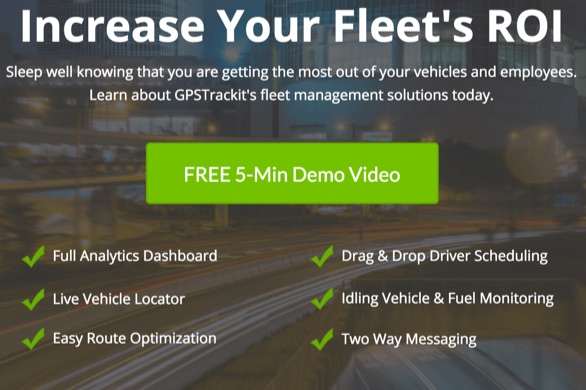
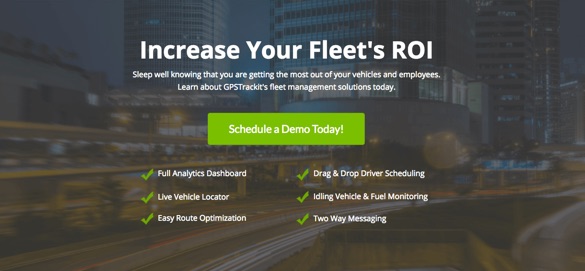
The results were powerful.
By changing the offer to a demo video instead of a scheduled demo, the conversion rate went from 1.7% to 15.3%-a 9X increase. The offer of the free demo won in a landslide.
Although nothing on the page changed except the text describing the offer, this mattered a lot from the customer's perspective.
Why? Most people aren't enthusiastic about scheduling a demo or a consultation because it requires them to (1) wait, (2) coordinate their schedule, and (3) commit a fixed amount of time.
The “free 5 min demo” offer converts much better, because customers can watch it right away without a phone call.
Side note: We recently tested this same idea of a free demo offer on our pricing page vs. scheduling a consultation. The data is still coming in, but lead conversions are up significantly.
This example illustrates that structural changes are most important when you are thinking about “big changes.” Structural changes include a difference in the number of steps or the offer itself.
This is different from merely changing design or copy, because it represents a more significant change to the customer's experience in your funnel.
As a result, the change is more drastic and so are the results.
Freemium vs. Free Trial
When I started my first SaaS business, we offered a free trial.
Later, we removed it and went from generating weekly sign-ups to zero (bad move, duh).
A better example here is Mailchimp. After building a profitable business with 100,000 users, they went freemium in 2009 offering free email marketing accounts to 500 subscribers.
One year later, they reported a revenue increase of over 150%.
How to Apply it to Your Marketing Funnel
If you're not converting or you see a big bottleneck in your online sales funnel, start with a BIG change.
Go big or go home! If you're only seeing a “trickle” of people moving from one step to the next, the issue is probably bigger than simply, “Oh, let's test a different headline,” or “Oh, let's change the button color to yellow.”
The Bottom Line
The results may be positive or negative. The important thing here is that you won't really know which version is more effective unless the spread is statistically significant.
When creating an A/B test or a sequence test to improve your conversion rate, go for big changes. Little changes (usually, but not always) yield a proportionally smaller result.
So blow a hole in the mountain.
Challenge your assumptions.
And take a walk in your customer's shoes.
Big changes mean big growth for your bottom line.
Third Law of Sales Funnel Physics: Law of Repetition
What is it?
You've probably heard some guru say that people don't remember a brand name until the 7th time they've heard it.
This is not that.
The Law of Repetition says that following up multiple times (via email automations, retargeting ads, or call-to-action buttons on your website) will cause more conversions within your funnel.
Yes, you could say that this law is saying, “beat your prospect over the head with your offer enough times, and you'll get more sales.”
That's true, and it's why spammers use this technique.
But I am not advocating for that. Rather, I am giving you this universal pattern with the hope that you will use it responsibly.
Let's look at a few examples.
Examples:
The Law of Repetition is about repeated messaging and consistent follow-up.
This happens when you are presented with multiple lead magnets asking for your email address.
For instance, Clay Collins and co. over at Leadpages have repeatedly pointed out that each of their blog pages have multiple offers and CTAs. This, in turn, has helped them quickly build an email list of 200,000+ email subscribers.
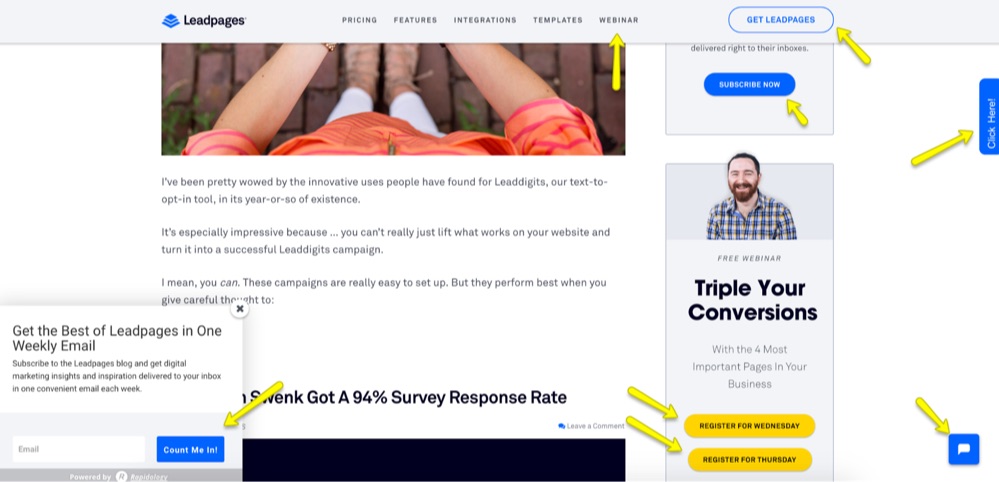
I applied and refined this technique on my company's website in 2014 and later wrote about the results in a guest post on Leadpages. I gave the method a name-“The Every Page Rule.”
The Law is always in effect when you implement email follow-up sequences or retargeting ads.
In 2013, I tried my hand at launching an info product. The email sequence I wrote was “OK” so I rewrote it and kept iterating.
The final sequence was aggressive with the follow-up, but the truth is that it worked. People bought the course at a very consistent rate.
Noah Kagan later reminded me of this principle when he published some research from people using his SumoMe tool to help people build their email lists faster.
The research showed that people were more likely to opt-in if they were repeatedly shown the pop-up on a website until they signed up.
Again, not saying that's the best way to do it. In fact, I would say being too aggressive makes you look not cool.
Want another example? Look at the Kissmetrics funnel. If you sign-up for a free trial or opt-in to one of their lead magnets and request a demo, you are instantly entered into a follow-up sequence where an Account Manager will contact you to schedule a demo.
And here's one more from a little-known multi-billion dollar company called Amazon.
Ever heard of Prime?
Prime is a premium subscription which gives Amazon customers perks like free 2-day shipping and access to streaming movies.
The Amazon website is covered with call-to-action buttons for Prime, and 54 million customers have opted into this service as a result.
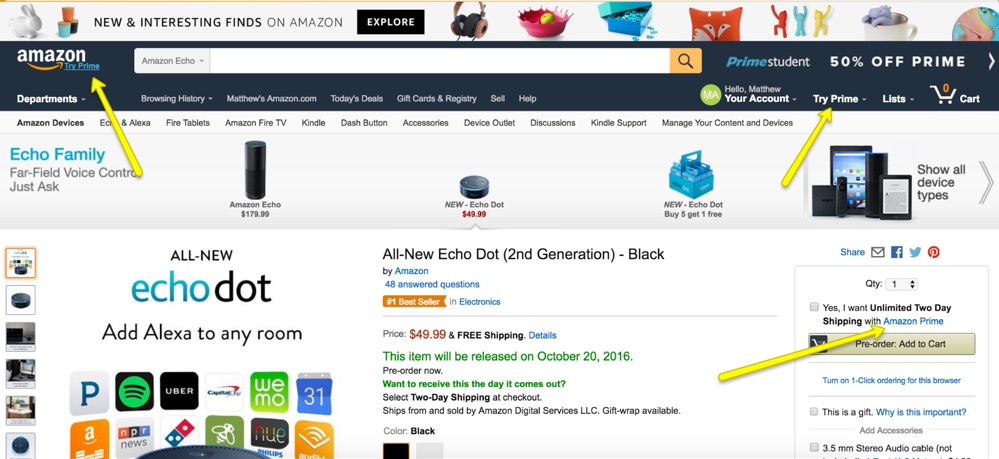
How to Apply it to Your Marketing Funnel
If you're a SaaS business, you can apply the Law of Repetition in a variety of ways to your own sales funnel.
Here are the best ideas, in order of priority:
- On-site CTAs that are clear and relevant to the stage of the funnel the prospect is in.
- Follow up with potential customers using an email automation to get them on the phone, get their feedback, or nudge them toward signing up.
- Show an ad or link in your blog's sidebar or navigation, along with an exit pop-up, to promote your lead magnet and grow your email list.
- Get more return traffic with retargeting ads. Make sure to segment visitors based on where they are in your funnel. For instance, you may want to treat people who reached your checkout page differently from those who signed up for your free 5-day e-course.
- Finally, you can get more advanced using a combination of tactics (Think: Amazon + Smart Funnels). For instance, after a customer checks out, you can upsell him/her on the benefits of the next level pricing package. Similarly, when he/she comes back to the website later on, he/she will see CTAs on the blog nudging him/her and offering benefits for upgrading. This can also be done over a course of weeks or months via automated email follow-up to anyone who has purchased.
The Bottom Line
Repetition yields higher conversion rates and can also increase the value of an average customer to your business.
Don't let leads forget about you and your services-constantly remind them of what you offer and how it can benefit them.
Just be sure not to overdo it, or you risk hurting your brand.
Fourth Law of Sales Funnel Physics: Law of Clarity
What is it?
“Better to be clear than clever.”
When I was a little kid, I'd go to the doctor at least once a year for my checkup.
I remember the waiting rooms were always gray and super boring.
So I'd pick up one of the outdated magazines they had laying around and flip through it.
I found most of the ads weird and frustrating, because I couldn't tell what they were trying to sell.
Did they want to make money, or just confuse people? It was unclear to me.
Turns out, I was on to something.
Fast forward years later to the first time I heard the expression, “Better to be clear than clever” from Dane Maxwell, a serial entrepreneur, while he was being interviewed by Andrew Warner from Mixergy.com.
This expression highlights the biggest reason why most sites don't convert well in the first place: people don't buy what they don't understand.
Many people make the mistake of focusing on creating a catchy headline, instead of focusing first on customers' understanding by creating effective copy for their sales funnel.
Consider a few examples.
Examples:
The following case study documented on Visual Website Optimizer's blog illustrates how clear copy converts.
Movexa is a supplement product with a direct response website funnel. In other words, they are looking to make sales directly to people visiting their site.
In an A/B test where they clarified what the product was by adding the word “supplement” in the headline, sales increased by nearly 90%!
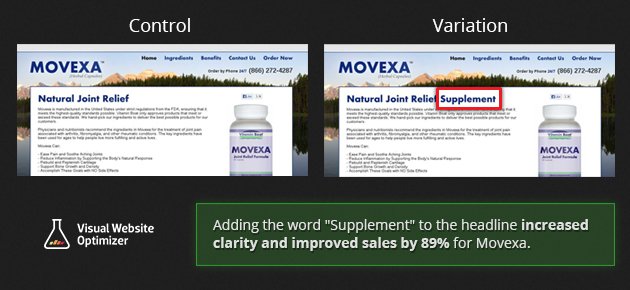
Here's another example from a company selling personal training subscriptions.
As cited by Unbounce, the company A/B tested a clearer “boring” and uncreative headline against the original.
The result? 38.46% more training memberships were sold.
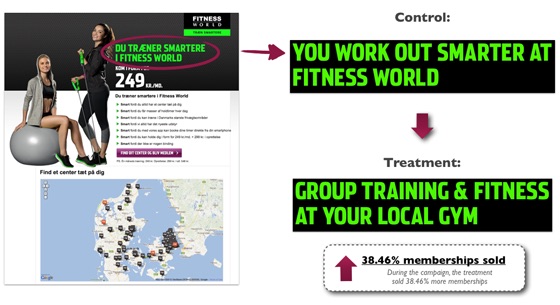
Michael Aagaard, the author of the case study reflected after the fact:
“I have yet to see a creative headline beat a clear headline in an A/B test.”
Clarity over cleverness, indeed.
Further, research has consistently confirmed that website users prefer copy that is “simple and direct.” Here are a few key nuggets from the research conducted by the Nielsen Norman Group:
- “Users often leave web pages in 10–20 seconds, but pages with a clear value proposition can hold people's attention for much longer.”
- Users will often have multiple windows or tabs open and leave and come back to your site within a single session. When this happens, having clear straightforward copy helps the reader to re-establish context.
- Of the first three items a user focused on, almost 80% was on text, not graphics.
- Reduce use of wording that could be seen as marketese (i.e. clever copy or slogans) in order to build trust.
How to Apply it to Your Marketing Funnel
Of course, you could jump right into A/B testing.
But this wouldn't be much better than taking a wild guess.
You'll be more likely to see growth if the changes you make are inspired by feedback from prospective customers. You want to hear from users currently “stuck” in your funnel who are actively considering your product.
You want to hear the questions they have, ask them open-ended questions, and hear how they react to your website's current copy.
Here are the two best ways to do that:
- User feedback survey tools can be set to automatically ask visitors leaving the site a question. Survicate is a free tool that works well for this purpose. HotJar is also a very solid option with lots of additional features, which now has a free plan for basic use as well.
- Order a user test where complete strangers will test your website. It's ideal if you have people in your target market test the site, but when it comes to knowing if your website communicates clearly, feedback from strangers can provide a just as actionable insight. I recommend browsing Fivver for user testing services or check out UserInput.io (this one gives you more options for targeting).
After you have some actionable feedback (make sure you get enough so you notice patterns), it's time to test.
If you have less than 10,000 visits per month, it could take a while to reach a high level of statistical significance for your A/B test. It might not even be worth a/b testing.
In that case, you might just want to do a sequence test (“before and after”). With this test, you can see an impact on your bottom line in as little as a month with a reasonable degree of certainty. Just make sure you are accurately tracking results before and after, while also tracking conversions that matter, like leads and sales.
For example, at Petovera we saw 25% MRR growth from June to July after we re-launched our new homepage, pricing page, and free email course.

The sales results from this test were so significant compared to other months. When considered with the fact that no other major component changed on the site, the only conclusion we can draw is that the changes caused this growth.
Note: This example highlights both the application of the Law of Clarity (we did research on our target audience's needs and questions before rewriting the copy for greater clarity), as well as the Law of Big Changes covered above (copy completely revamped along with the design).
The Bottom Line
The words you use to communicate about your product matter more than design.
Site visitors need to trust you; providing them with a clear understanding of the product's value and how it works is a critical lever for growth in your sales funnel.
Fifth Law of Sales Funnel Physics: Law of Proof
What is it?
People buy what other people buy. That's because we seek to minimize the risk of potential loss by relying on what other people are saying.
We are programmed to be loss-averse creatures.
Don't believe me?
Watch yourself the next time you are picking out a movie on Netflix or browsing for a new book on Amazon.
Personally, I won't buy a new book without at least 250 reviews and an average rating of 4 stars or higher. Even 4 stars is “iffy.”
I use the same risk minimization when it's time to kick back and enjoy a new movie on the weekends. Less than 4.5 stars? That's a no-go.
Your habit for loss aversion might be slightly different. Maybe you read individual reviews.
The point is, your customers operate the same exact way when they enter your sales funnel and become interested in your product.
The Law of Proof says that people are more likely to invest time and money in that which they see as low risk and likely to give them the result they desire.
Proof (or “social proof”) can come in a wide variety of forms:
- Testimonials
- Reviews
- Case studies
- Examples of past work (e.g. from a designer's portfolio)
- Vanity stats (e.g. “over 10,000 happy customers serviced since 2010”)
- Customer logos
- Press logos
- Networking groups
- Third party accreditations (e.g. certified Google Adwords Partner)
Other than making your business look legit, social proof elements will increase conversions in your funnel.
Example:
WikiJob, a website with over 500,000 monthly visitors ran an A/B test on their homepage.
The one thing they changed? A simple testimonials section was added. Here's what it looked like.

The result?
Here's the response from the company owner:
[Adding the] testimonials increased sales by 34%. The testimonials we used are very 'sober' (compared with the overly enthusiastic ones you so often see in marketing literature). The test results were surprising. Although such increases of sales can be quite normal in split testing, I did not think that testimonials would make such a difference (and indeed put off testing them, thinking they were irrelevant). The increase in revenue was very substantial.
Social proof can make a huge impact because it influences how trustworthy people perceive your brand to be. It lowers perceived risk.
Research from Nielsen showed that 70% of people trust recommendations from people they don't even know. That's compared to 90% of people trusting recommendations from people they do know.
How to Apply it to Your Marketing Funnel
Test adding social proof on key landing pages.
Generally, it's a pretty safe bet ASSUMING you have taken into account the context and the user's intentions for that POINT in your funnel.
Here's what I mean:
Derek Halpern documented a case where adding social proof did not grow conversions. See graphic below where the middle version won.

However, this is actually an example of the Law of Friction (discussed below) vs. The Law of Proof and NOT an argument against the effectiveness of social proof in general.
The middle example simply requires less “mental load” to understand. It could be as simple as the fact that the number “14,752” is difficult to read and the middle variation is visually more attractive because it is simpler.
Similarly, last year we A/B tested a Leadbox for our newsletter in the sidebar of our blog.
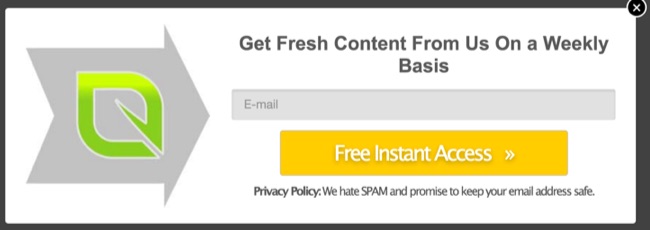
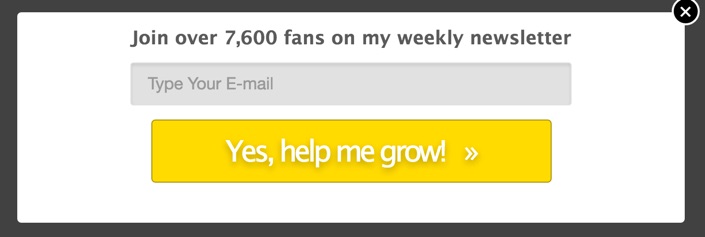
Here are the results:

The one without the social proof won by a large margin.
Here's one more case study to drive home the importance of understanding context and user expectations when considering where to integrate it in your funnel.
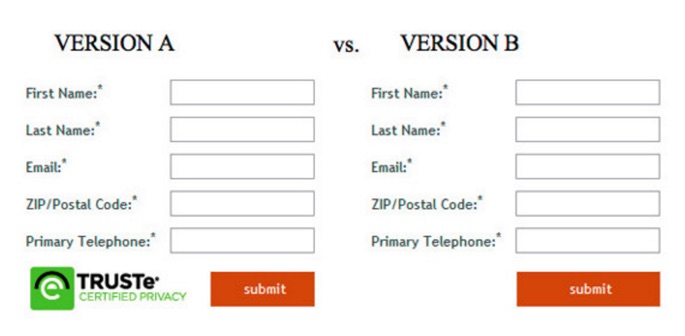
Security seals-also a common example of social proof-build trust, right?
Well, it didn't work as one might have expected when tested on this lead generation form.
Version B increased conversions by 12.6%. In this case it didn't work out, because security seals are associated with online checkout. As a result, users were confused or put-off by it.
The Bottom Line
Social proof is a key point of leverage when optimizing your sales funnel.
However, you'll need to A/B test to know for sure. If your traffic is too low for A/B testing to be a realistic option, do a sequence test after taking into account user context and intentions.
Sixth Law of Sales Funnel Physics: Law of Friction
What is it?
Since I began my career as a web-based entrepreneur at 19, I've done many A/B tests and been part of many research-based website design projects.
I've spoken with hundreds of business owners about their conversion issues since that time.
I'm always learning, but I can say from experience that this issue is one of empathizing with the end user who is on your website.
That's what it comes down to because people on your website have goals.
Often the business owner doesn't know the potential customer's goals or how their website is “blocking” these customers from buying.
This is what is meant by friction. When friction is minimized-and a user's goals are made easier to accomplish-conversions go up.
Let's look at a few examples that support this principle.
Examples:
An online retailer was able to increase annual revenues by $300 million by changing a button.
In a now-famous case study, Expedia was able to increase profit (not sales) by $12 million by removing a single text field from their checkout form.
And Barack Obama's re-election campaign was successful in part because of rigorous A/B testing that minimized friction and in turn grew donations by 49% and sign-ups by more than 161%.
Let's walk through each case briefly.
Kyle Rush was on the optimization team for President Obama's re-election campaign.
They conducted numerous tests, and in his own words, Kyle explained how much he was able to learn due to the high traffic the site received.
This made A/B testing different designs and copy ideas easier, because they only had to wait days or even hours for results.
Here's the law of friction at work in one of their tests.
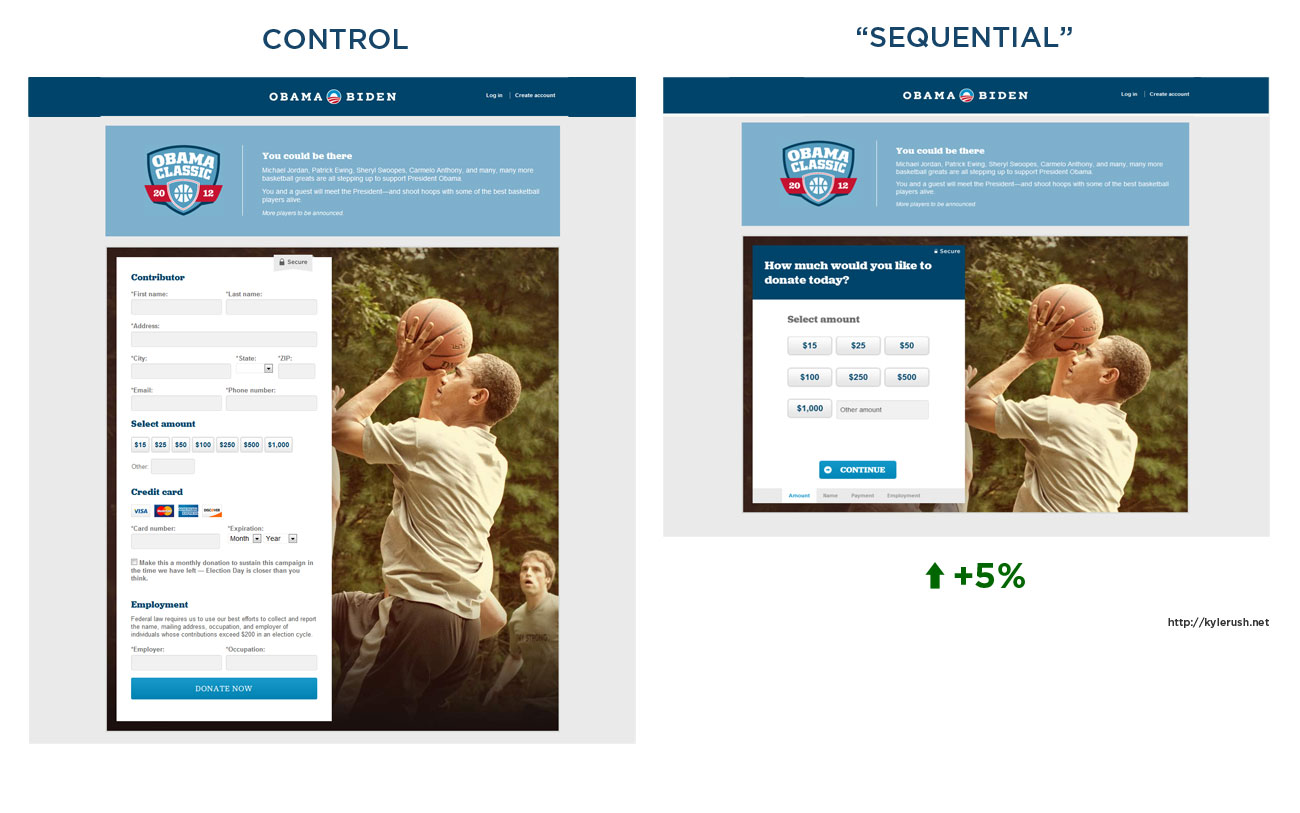
In the variation they tested on the right, the idea was, “maybe we can convert more people to make a donation if we make the donation process appear easier by breaking it into steps.”
The result was a net increase of 5% in donations. It might not sound like a lot, but over the course of a campaign and raising many millions of dollars, it is.
Jared Pool observed the Law of Friction at work for a major online retailer. He saw that 160,000 people per day were requesting a password reset on their account prior to checkout, and 75% of these people ended up not completing their purchase.
The issue was people would go to check out and be confronted with a simple but supremely annoying form that asked them to register in order to check out.
As one user who tested the site for Jared said:
“I'm not here to enter into a relationship. I just want to buy something.”
The solution? They replaced the Register button with a Continue button and added a note:
“You do not need to create an account to make purchases on our site. Simply click Continue to proceed to checkout. To make your future purchases even faster, you can create an account during checkout.”
The result? $15 million in new sales in the first month and +$300 million in additional sales for the first year.
Finally, the case of Expedia:

Simply by removing the “Company name” field, profit (not sales) grew by $12 million per year.
Of course the question is, why?
Well, the field simply confused users and set the wrong expectation. For instance, some thought that company name meant the name of their bank, which would cause them to put in the wrong billing address and then the payment would fail. This, in turn, killed sales.
The user interface was causing friction in this case.
Or, as Jon Correll from Conversion VooDoo put it,
“Conversion rate optimization gains are often just a function of getting your broken UI the $!@$!@ out of the way of your end user.”
How to Apply it to Your Marketing Funnel
Start by understanding where the bottlenecks are in your sales funnel.
Where are people dropping off? Look for outlier numbers.
For instance, a couple of months ago I saw that 60% of people clicked through from our homepage to our pricing page, but then only 7% made it to the checkout or consultation pages.
Numbers like this serve as a compass because they point you toward what should be worked on.
Next, as I discussed in Law of Clarity above, you want to gather lots of feedback from users.
You can have strangers test it, or you can talk directly to existing users of your site.
Both have worked in my experience. However, getting at least 10–15 people from your list of existing users will yield more accurate results.
If you're doing it over the phone, establish rapport first, then ask open-ended questions and listen.
Maintain detailed notes as you go through this process. Look for patterns, but NEVER guide or do anything to influence the answers.
Again, you are gathering this feedback, because without this data, you will not gain a clear understanding of what is blocking sales on your site.
Once you have identified a pattern-perhaps a recurring type of complaint directly related to the bottleneck in your funnel-then you can start testing possible solutions.
Don't expect an immediate $300 million change in your business overnight, like in the example above.
But also don't underestimate the impact you can have with small, deliberate changes that work to address the source of friction in your funnel.
The Bottom Line
Friction is caused by design or copy that is not fully optimized to help people entering your funnel accomplish their goal. This matters whether their goal is buying from you or efficiently learning what you have to offer.
Seventh Law of Sales Funnel Physics: Law of Alignment
What is it?
Johnny rides a red bike.
He arrives at your imaginary bike store.
You try to sell Johnny a new set of tires, but he declines.
Why did Johnny not buy? Because the offer wasn't aligned with his needs.
The difference between alignment and friction is that friction comes after alignment in the buying process.
Alignment deals with helping customers to identify the need your product can address.
Friction deals with the interactive experience of buying and how easy or difficult it is.
Alignment deals with the customer's intentions, questions, or context (like what previous website or page the customer came from).
Get it? Got it. Good!
Examples:
Here's an intriguing case study to demonstrate the Law of Alignment in action.
An SEO link-building company called The HOTH originally relied on a fairly straightforward homepage to generate leads for its service.
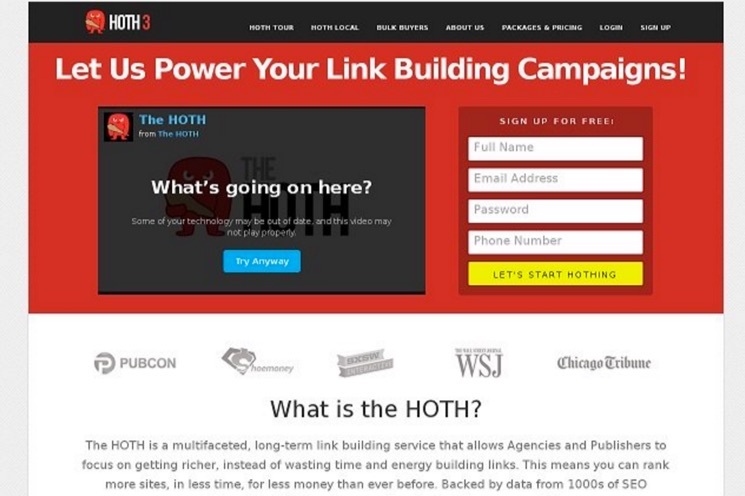
Leads were converting on the page at 1.39%.
Ok, not terrible.
So they tested the page against a minimalistic design.
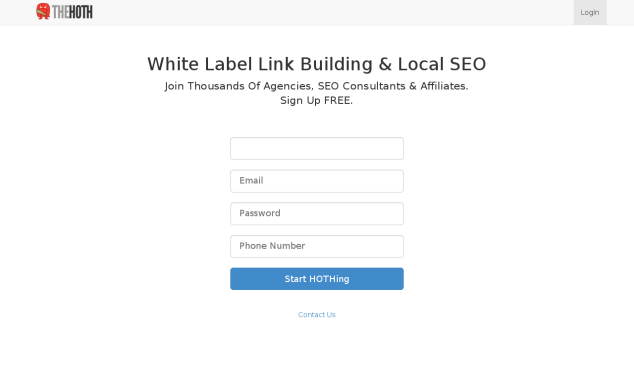
The results? 13.13% or almost a 10X increase in the number of people converted to leads by creating an account.
The reason this worked was explained by the case study's author:
[The] majority of visitors coming on The HOTH website were from the direct and referral category. Hence, they had some background knowledge of the company already. This was also true for the social traffic. A very large portion of their search traffic also came from branded keywords…
In other words, the context of the people arriving on the page meant that they didn't need a lot of information about the service in order to convert. They were already aware of the company's service, and many already had some trust built with the brand.
The simplicity of the form aligned best with what they already knew or felt about the company's offer. They didn't need a long landing page in order to convert.
Important note: The HOTH's website today looks a little different, with a video at the top above the form. This pushes the form and call-to-action button further down, below the page.
I would speculate that this introduces some friction on purpose.
Why?
I would guess-from direct experience doing lead generation for similar businesses-that the friction is good, because the leads are more educated and higher quality.
After all, you have to assume that a significant percentage of the traffic that does come to that homepage isn't 100% familiar or clear on what the company has to offer.
Here's one more example to prove the pattern of the Law of Alignment.
A personal organization service drove search traffic to a landing page via pay-per-click ads.
Which version do you think won?

Version B would seem to have a clearer, more benefit-oriented headline and subheadline.
But actually version A was the winner, increasing leads by 115%.
The reason is version A's copy was written to align with the PPC ad copy that the user clicked on before arriving to the page.
The ad created an expectation of ideas in the mind of the user. So arriving on the page where the copy complemented and reflected those same ideas made them more likely to convert.
How to Apply it to Your Marketing Funnel
Traffic arrives on your website from five basic sources:
- Direct (people typing in your website or clicking a link in your email)
- Search
- Social Media
- Referral
- Paid ads
The source heavily defines the context for people on your site.
One key to using the Law of Alignment in your funnel means tailoring the page that people enter into your website to the context of the traffic source.
Of course, you can take this to an extreme (i.e. if your traffic comes primarily from Google, that doesn't mean you should redesign your site to have a similar UI and layout to Google with the hope of increasing conversions).
A more practical approach is to ask yourself:
- How can we make that “on-ramp” into our funnel more inviting and anticipatory of the visitors' needs?
- What answers do visitors expect to find on each page based on what they searched for prior to arriving there?
- What reassurances, if any, do they need once they are in the funnel, browsing our site, and evaluating our product?
As covered above in the Law of Clarity and Law of Friction, you have to do your research and listen with empathy to gain the biggest insights that will lead you to alignment.
The Bottom Line
The context from which a visitor comes to your site needs to be addressed, as does how you will deliver the information they need prior to making a buying decision.
Conclusion
I titled this article as “Sales Funnel Physics” because as in physics, these laws identify the universal principles behind why people do or don't buy online, assuming there is a market need for the product.
I have not been able to find any case studies or A/B tests that do not fall under one or more of these principles:
- The Law of Visibility says that offers must be seen in order for sales and conversions to occur. Sounds obvious, but it's too often forgotten.
- The Law of Big Changes says that as a general rule, testing more significant structural-, copy-, or design changes to your funnel is a best practice. This is because big changes will cause proportionally more varied results than small changes. It doesn't have to “look” like a lot of work, as long as it is significantly different from your customer's perspective.
- The Law of Repetition is different from the Law of Visibility, because it says that the frequency of exposure to your offer has a direct impact on conversion rates. More exposure to the offer causes more conversion, though ROI diminishes after a point because people get annoyed.
- The Law of Clarity says that before people become interested and decide to buy your product, they must first understand what it is.
- The Law of Proof says that people care a lot about whether or not your product actually does what it claims. People are risk-averse, so they desire proof in order to minimize perceived risk before buying-in the form of testimonials, case studies, etc.
- The Law of Friction says that the easier you can make the experience for an interested buyer, the more likely he/she will buy!
- Finally, the Law of Alignment says that people will convert more often on offers and landing pages that better align with their context, like from which site they just came.
Have you noticed similar patterns when designing your sales funnel?
How will you apply the Laws of Sales Funnel Physics to grow your business?
Tell me about them in the comments and I'll respond :-)
About the Author: Matt Ackerson is the Founder of Petovera, a company that specializes in growing email lists faster with a pop-up optimization service. Business owners never have to lift a finger and you can see the results each month. Kissmetrics readers can grab an exclusive copy of the Law of Funnel Physics summary today, along with our free 5-day email course: How to Double Your Leads in 30 Days.

